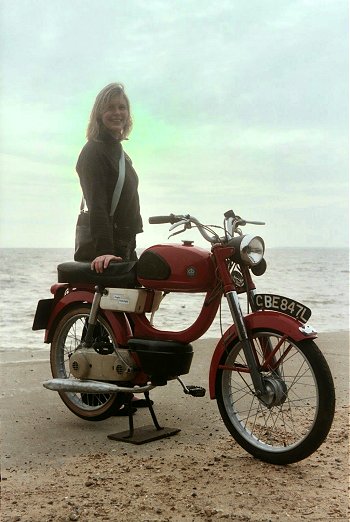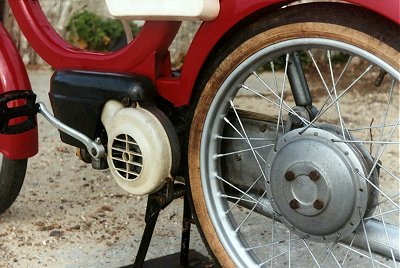

Last issue’s lead feature links us to several threads as Piaggio’s web sprawls across Europe, and we follow one of these time trails to another business back in England—even before Piaggio started!
Our mini-feature starts in 1882, with the founding of a company to manufacture boot-making appliances, and going on to produce its first motor cycle in 1907: Douglas.
This company’s famous motor cycling exploits are more than adequately covered by many mainstream publications, so we have no need to concern ourselves in repeating the obvious. Our interests are much more obscure, so we pick up the tale 44 years later, as Douglas entered into arrangements to build Vespa scooters under licence in the UK, the official launch of which took place in March 1951. Douglas-built Vespas differed from their continental cousins in featuring British component fittings from Amal, BTH, Lucas, Wipac, and others.
Continuing its spread across Europe, in 1952 Piaggio founded a factory in Madrid in collaboration with the National Institute of Industry (INI), and John Llado (then CEO of Banco Urquijo). MotoVespa SA was set up to manufacture scooters, and its first Spanish-built 125cc Vespas took to the streets in February 1953.
Douglas was taken over by The Westinghouse Brake & Signal Company late in 1956, and the production of its motor cycles concluded in March 1957, though Vespa assembly ran on to 1960, after which the business continued to act as import agent and market factors for Piaggio.

1969 Vespino Tourist
In 1967, MotoVespa embarked on a new project to design a more economical product, and registered a Spanish patent for a new fan-cooled, automatic CVT engine (Continuously Variable Transmission), from which the Vespino was born on 19th February 1968. The base moped model was the ‘Tourist’ with telescopic forks, then joined in 1970 by a cheaper ‘Brisa’ leading-link fork version, and ‘Rally’ sports-styled version of the ‘Tourist’. So, registered on 1st June 1973 as a Douglas/Vespa Vespino Tourist Rally, and 91 years from the start of our little tale, we finally arrive at the subject of our feature!

The styling looks pretty groovy in a period kind of way, and you have to give MotoVespa credit for taking the trouble to design some fashionable flair and character into their creation, at a time when many moped manufacturers were producing relatively soulless equivalents. The sports styled ‘Rally’ catches the eye and is interesting enough to make you want to look at it in a little more detail.
There’s a chunky decompressor lever under the twistgrip, and another chunky choke lever under the left-hand cluster. Then you notice something rather odd—there appears to be a twist throttle on both sides! On investigation, by cable operation, the left grip turns back for pedal mode, and forward to engage engine drive.
A Spanish Rinder 110mm headlamp houses a 40mph Veglia speedo, and with the Wipac rear lamp, confirms that this is a genuine UK market machine and not some dodgy grey import. Tank badges wear the Piaggio logo, but carry the MotoVespa brand. ‘Vespino’ is printed on the back of the dual seat, but there’s nowhere particularly obvious to locate any rear footrests if you wanted to, since there’s not really any suitable mounting point at all on the right-hand belt side. Having single-sided suspension, there’s nothing at all on the left, which makes the rear wheel dead easy to get out—just four bolts on the hub.

Flip back the plastic motor cowling on its sprung loaded hinge (that’s neat), and check out the engine. There’s a Dell’orto SHA 14-12mm carb feeding into the crankcase, so that’s rotary valve, with fan-cooling, and what appears to be an early Femsa electronic ignition package entombed in resin, hanging off the front right-hand side of the primary gear case. Specifications rate output to 2.2bhp @ 4,700rpm, which might seem slightly inadequate for a ’70s sports-styled moped, and our apprehension further mounts as we note the Douglas sales leaflet quotes max speed at 40km/h—er, that translates to around 24mph in real money!
The engine fires up with a typically continental flat crackle, but on pulling away, our worst fears are quickly realised. Acceleration—nope! Just a gradual building up of momentum, to a paced 24mph on the flat, with a matching 24 reading on the Veglia. Best downhill paced at 31, with the Veglia agreeing again, then plodding up the incline on the other side at a laboured 21mph. Performance on the flat is limited as the motor breaks into unpleasant bouts of 4-stroke phasing from 22mph due to inadequate porting, the only way to treat this being to back off the throttle.

Brakes are good enough, but unlikely to be challenged by the disappointing performance, though the front drum creaks in operation. The battery-less lighting generator outputs 6V at 28W, to manage no more than a dull shine with which to struggle your way slowly around the dark country lanes. Ride and general handling is fine, but the sports styling would lead most riders to expect something that went appreciably better. With introduction of the law limiting 16ers to mopeds from 1st August 1971, few teens would have been much impressed by the Vespino Rally, being left well behind as their mates rode off into the sunset on Fizzys. Douglas must have been quite conscious of the Vespino’s stunted performance when printing the UK sales leaflet, otherwise, why post a 40kph top speed for a bike with a mph speedo? They probably hoped no-one would notice!
Though popular back home in Spain, Vespino Rally sales must have been as limited as its performance over here, this is the first UK version we’ve ever seen in the flesh.
With Piaggio’s acquisition of Gilera in 1969, Douglas also became UK sales franchisee for that brand.
Douglas import licensing ended in mid 1982, concluding the names association with two-wheelers.


Next—Our next support feature starts with what might appear to be the most powerful machine we’ve tested to date, with a specification of 4 × Rolls-Royce Avon Mk524 turbojets delivering 10,500lbf each (total 42,000lbf), for a max speed of 500mph? But Fly Me may not be what it may seems…
This article appeared in the October 2008 Iceni CAM Magazine.
[Text & photos © 2008 M Daniels. Period
documents and pictures from IceniCAM Information
Service.]
Our Douglas Vespino Rally came along quite unexpectedly for Iceni CAM Magazine 7, when Mick Spacey incidentally mentioned that he’d picked one up, and might we be interested in it for feature before he moved it on? Too right we would! Whiz straight up there at the weekend in the van to pick the bike up, a little tidying for the road test, then down to the waterfront for a seaside picture set. Since the bike looked kinda groovy, we rather fancied getting a model for the photoshoot, but because everything happened so quickly there wasn’t time to arrange anything like that. As it turned out, Mary just happened to be walking past with her boyfriend, so ’would she care to stand in some shots for us please?″ Yes, of course she would; people are nice like that.
By Wednesday the bike was posted up for sale on IceniCAM Market, then whisked away to its new owner, and all within a couple of weeks!
Total cost of producing Latin Flair, was £23.50 (£15 fuel, £8.50 film, developing and CD), and Neil Morley of East Anglian Cyclemotor Club Suffolk Section collects sponsorship credit on this one.